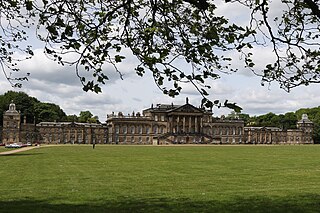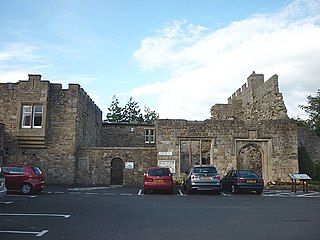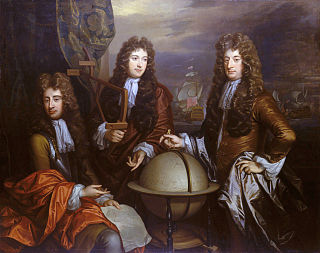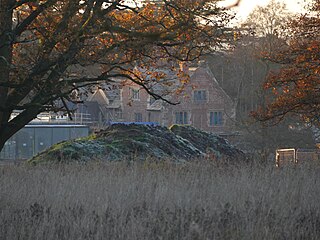
Wentworth Woodhouse is a Grade I listed country house in the village of Wentworth, in the Metropolitan Borough of Rotherham in South Yorkshire, England. It is currently owned by the Wentworth Woodhouse Preservation Trust. The building has more than 300 rooms, with 250,000 square feet (23,000 m2) of floorspace, including 124,600 square feet (11,580 m2) of living area. It covers an area of more than 2.5 acres (1.0 ha), and is surrounded by a 180-acre (73 ha) park, and an estate of 15,000 acres (6,100 ha).

Seaton Delaval Hall is a Grade I listed country house in Northumberland, England, near the coast just north of Newcastle upon Tyne. Located between Seaton Sluice and Seaton Delaval, it was designed by Sir John Vanbrugh in 1718 for Admiral George Delaval; it is now owned by the National Trust.

Wrotham Park is a neo-Palladian English country house in the parish of South Mimms, Hertfordshire. It lies south of the town of Potters Bar, 17 miles (27 km) from Hyde Park Corner in central London. The house was designed by Isaac Ware in 1754 for Admiral John Byng, the fourth son of Admiral George Byng, 1st Viscount Torrington, and remains in the family at the heart of a 2,500-acre (10 km2) estate. It is one of the largest private houses near London inside the M25 motorway. Its distinctive exterior has been used over 60 times as a filming location.

Blenkinsopp Castle is a fire-damaged, partly demolished 19th-century country mansion, incorporating the ruinous remains of a 14th-century tower house, which is located above the Tipalt Burn approximately one mile south of Greenhead, Northumberland, England. It is a Grade II listed building; it is also a Scheduled Ancient Monument as one of the "surviving tower houses retaining significant medieval remains".

Doddington Hall is, from the outside, an Elizabethan prodigy house or mansion complete with walled courtyards and a gabled gatehouse. Inside it was largely updated in the 1760s. It is located in the village of Doddington, to the west of the city of Lincoln in Lincolnshire, England.

Ravensworth Castle is a ruinous Grade II* listed building and a Scheduled Ancient Monument situated at Lamesley, Tyne and Wear, England. The building has been destroyed and rebuilt a number of times, and was the seat of the Ravensworth barons, the Liddells.

Lilburn Tower is a privately owned 19th-century mansion house at Lilburn, near Wooler, Northumberland. The property is a Grade II* listed building and forms part of the Lilburn Estate. A number of discrete buildings and monuments are scattered across the grange, including the Hurlestone, Hurlestone Tower and an astronomical observatory.

Admiral Sir Ralph Delaval was an Royal Navy officer. He was a member of a junior branch of the Delaval family of Seaton Delaval, Northumberland. Delaval was born at Dissington Hall, Ponteland, an estate he ultimately inherited and sold to Edward Collingwood of Byker in 1673. He enlisted in the navy at a young age and progressed under the patronage of the Duke of York to become captain of the third-rate ship of the line HMS York.

Melton Constable Hall is a large country house in the parish of Melton Constable, Norfolk, England designed in the Christopher Wren style and built between 1664 and 1670 for the Astley family who owned the estate from 1235 until 1948. The core of the house is Elizabethan.

Blenkinsop Hall is a privately owned castellated 19th-century country house situated on the banks of the Tipalt Burn near Greenhead, Northumberland. The legal address of the property is Haltwhistle, Northumberland, NE49 9LY. It is a Grade II listed building. The property is located near Blenkinsopp Castle which is primarily a ruin; the castle was owned by the same family as the Hall for generations.

Newton Hall is an 18th-century country house at Newton on the Moor, near Alnwick, Northumberland, England. It is a Grade II listed building.

Hesleyside Hall is a privately owned 18th-century country house and the ancestral home of the Border reiver Charlton family about 2 miles (3 km) west of Bellingham, Northumberland. It is a Grade II* listed building.

Bavington Hall is a 17th-century privately owned country house at Little Bavington in Northumberland. It is a Grade II* listed building.

Peover Hall is a country house in the civil parish of Peover Superior, commonly known as Over Peover, Cheshire, England. It is recorded in the National Heritage List for England as a designated Grade II* listed building.

Ogston Hall is a privately owned 18th-century country house situated at Brackenfield, near Alfreton, Derbyshire. It is a Grade II* listed building. A building on the site is listed in the Domesday Book as part of the Deincourt manor of Morton. The Revell family of South Normanton held Ogston in the 14th century by marriage to the Deincourt heiress.

Alderley Old Hall is the remaining part of a former 17th-century manor house near the village of Nether Alderley, Cheshire, England. It stands adjacent to the mill pond of Nether Alderley Mill, a loop of which acts as a moat. The hall is recorded in the National Heritage List for England as a designated Grade II* listed building.

Rode Hall, a Georgian country house, is the seat of the Wilbraham family, members of the landed gentry in the parish of Odd Rode, Cheshire, England. The estate, with the original timber-framed manor house, was purchased by the Wilbrahams from the ancient Rode family in 1669. The medieval manor house was replaced between 1700 and 1708 by a brick-built seven-bay building; a second building, with five bays, was built in 1752; the two buildings being joined in 1800 to form the present Rode Hall.

Rise Hall is a Grade II* listed stately home in Rise, East Riding of Yorkshire, England.

Burrow Hall is a large 18th-century country house in Burrow-with-Burrow, Lancashire, England, which lies in the Lune Valley on the A683 some 2 miles (3 km) south of Kirkby Lonsdale.

Mamhead House, Mamhead, Devon, is a country house dating from 1827. Its origins are older but the present building was constructed for Robert William Newman, an Exeter merchant, in 1827–1833 by Anthony Salvin. The house is Grade I listed as Dawlish College, its function at the time of listing. The parkland is listed at Grade II*.





















